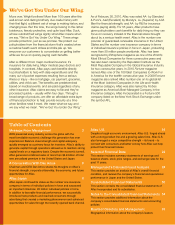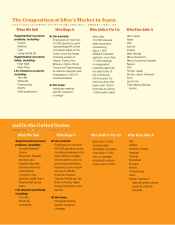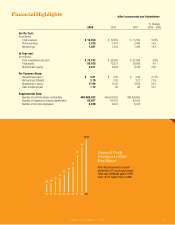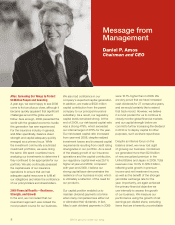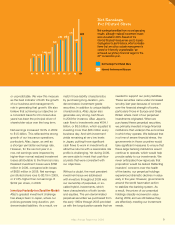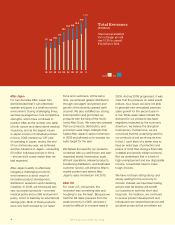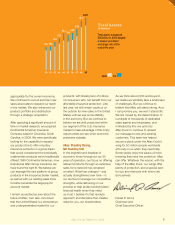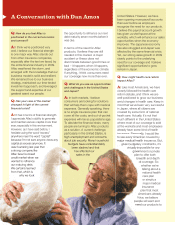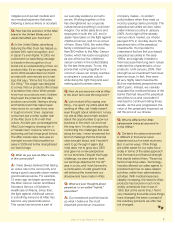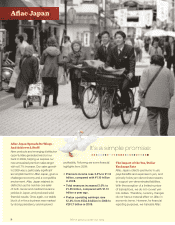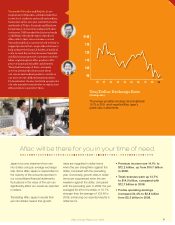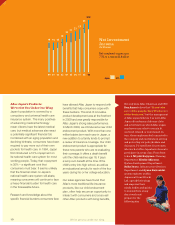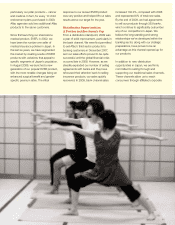Aflac 2009 Annual Report Download - page 7
Download and view the complete annual report
Please find page 7 of the 2009 Aflac annual report below. You can navigate through the pages in the report by either clicking on the pages listed below, or by using the keyword search tool below to find specific information within the annual report.
00 01 02 03 04 05 06 07 08 09
Net Earnings Per Diluted Share
Internal Performance Measure
1.26 1.22
1.49 1.47
2.45
2.922.95
3.31
2.62
$3.19
Net Earnings
Per Diluted Share
Net earnings benefited from record operating
results, although realized investment losses
were elevated in 2009. Based on the
internal financial measure we use to assess
management’s performance, which excludes
items that are either outside management’s
control or inherently unpredictable, we
achieved our primary financial target for the
20th consecutive year.
or unpredictable. We view this measure
as the best indicator of both the growth
of our business and management’s
role in generating that growth. We also
believe that achieving our objective on
a consistent basis for 20 consecutive
years has been the principal driver of
shareholder value over the long term.
Net earnings increased 19.3% in 2009
to $1.5 billion. This reected the strong
growth of our insurance operations,
particularly Aac Japan, as well as
a stronger yen/dollar exchange rate.
However, for the second year in a
row, net earnings were impacted by
higher-than-normal realized investment
losses attributable to the nancial crisis.
Realized investment losses were $788
million in 2009, compared with losses
of $655 million in 2008. Net earnings
per diluted share rose to $3.19 in 2009,
or 21.8% higher than net earnings of
$2.62 per share, in 2008.
Investing Prudently in a Sensitive Market
Aac’s greatest investment challenge
has always been in Japan, where our
policies generate long-duration, yen-
denominated liabilities. As a result, we
match those liability characteristics
by purchasing long-duration, yen-
denominated, investment-grade
securities. In addition to unique liability
characteristics, Aac Japan also
generates very strong cash ows.
In 2009 for instance, Aac Japan’s
cash ow to investments was ¥604.1
billion, or $6.5 billion, which equated to
investing more than $26 million every
business day. And with investment
yields remaining at very low levels
in Japan, putting those signicant
cash ows to work in investments at
attractive returns with a reasonable risk
prole is challenging. Yet during 2009,
we were able to invest that cash ow
at yields that were consistent with
our objectives.
Without a doubt, the most prevalent
investment issue we addressed
with investors throughout 2009 was
our ownership of perpetual, or so-
called hybrid, investments, which
have characteristics of both bonds
and equities. The yen-denominated
perpetual securities we purchased from
the early 1990s through 2005 provided
us with the long-duration assets that we
needed to support our policy liabilities.
These securities came under increased
scrutiny last year because of concern
over the nancial strength of banks,
particularly those in Europe and Great
Britain where most of our perpetual
investments originated. When we
purchased these perpetual securities,
we primarily invested in large nancial
institutions that underpin the economies
in which they operate. We believed that
in a time of severe nancial stress, the
governments in those countries would
take signicant measures to ensure that
these large banking institutions would
continue to operate, which would help
provide safety to our investments. We
never anticipated how rigorously that
proposition would be tested. Reecting
investors’ concerns over the health
of the banks, our perpetual holdings
experienced dramatic declines in value
early in the year. However, governments
around the world have taken action
to stabilize the banking system. As
a result, the prices of our perpetual
holdings steadily recovered in value
during 2009, and we still believe they
are effectively meeting our investment
needs.
Aflac Annual Report for 2009 3



